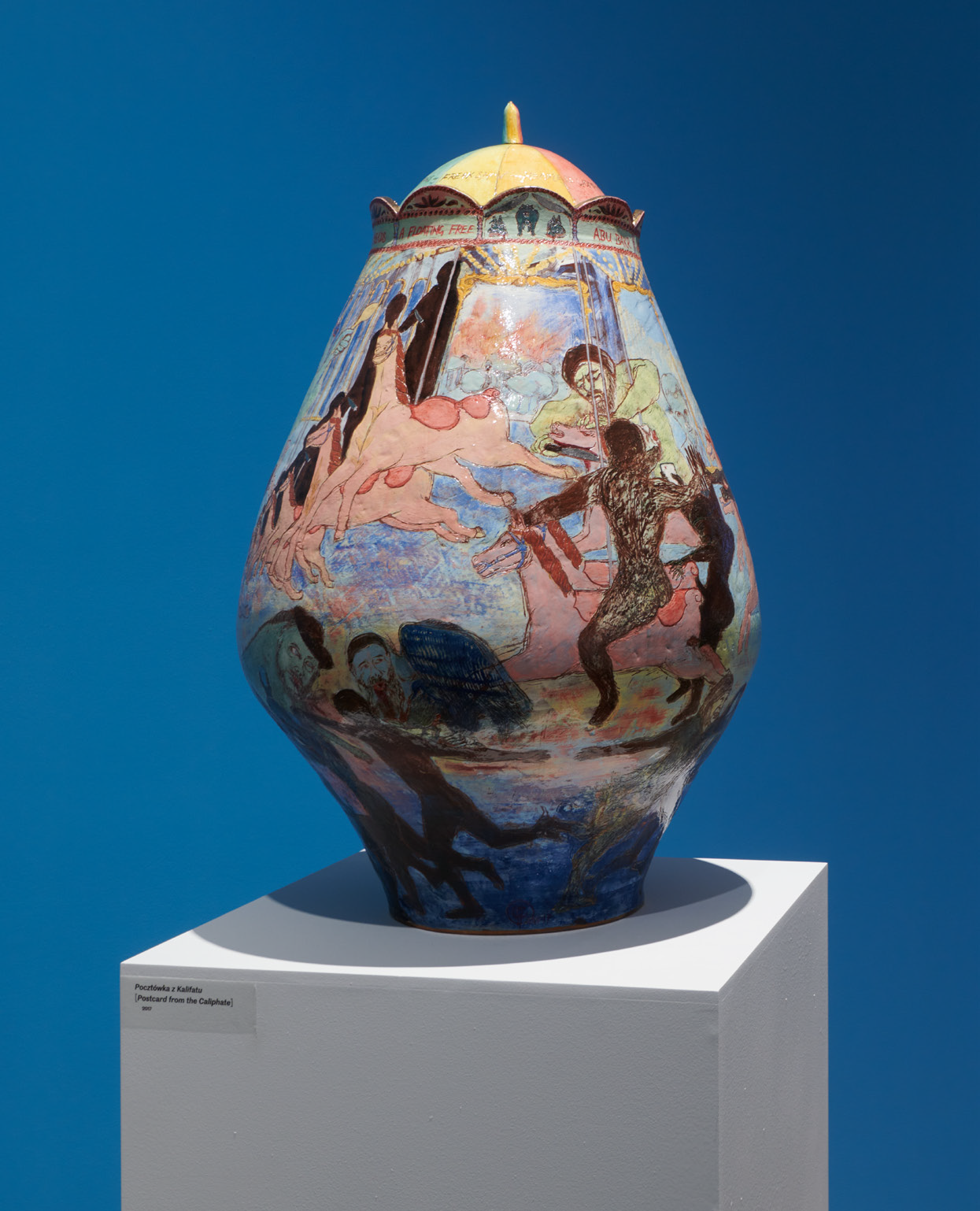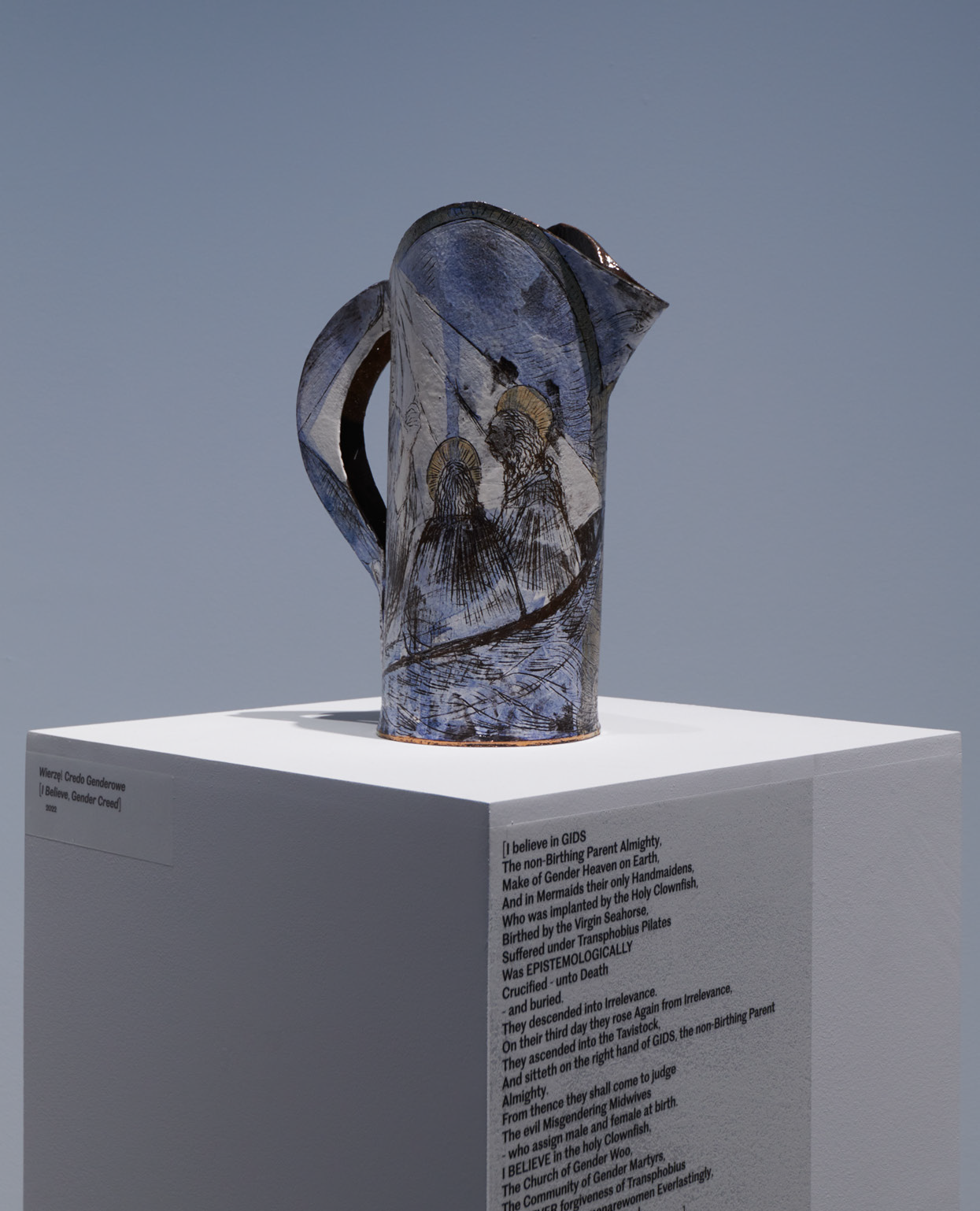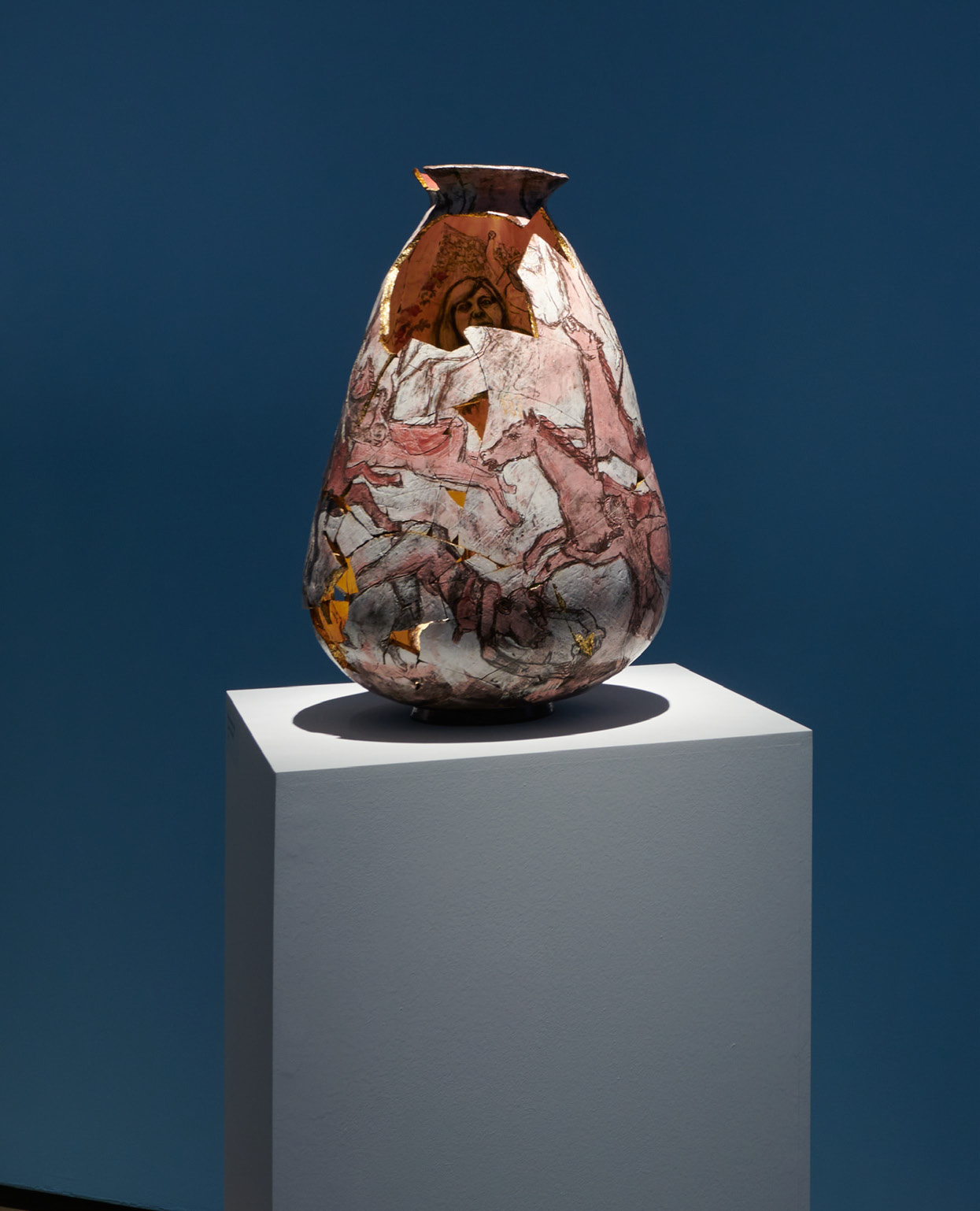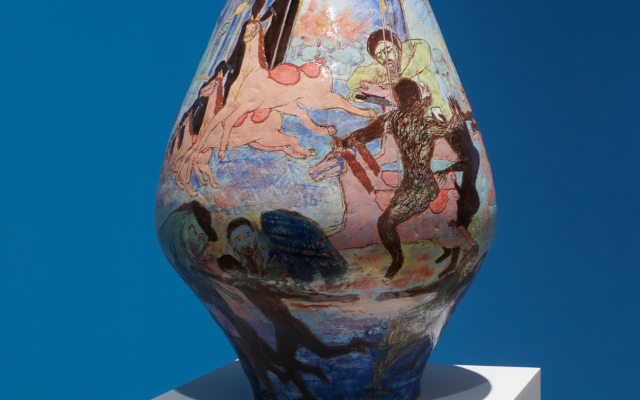It seems that, having learned from the history of totalitarianism, we have written freedom into the Universal Declaration of Human Rights and placed it at the centre, knowing that it is essential to avoid the tragedies we know from history. The freedom of art has a special place in this order; it is accepted that art is a field in which it is permitted to explore and cross boundaries, to break taboos or challenge dogmas. In this way, art in our culture has become a kind of litmus test for the freedom of speech, conscience, thought and religion so dear to liberalism. It is where the censorship of the arts begins that we need to take a closer look at what is going on.
Even if it happens in a democratic and free country, we must pause and consider whether we are dealing with authoritarianism or some attempts of implementing it.

Claudia Clare, Feminist Sattire. No Safe Spaces,
Exhibition at the Center for Contemporary Art,
Ujazdowski Castle in Warsaw
We take censorship and its authoritarian nature in culturally different countries for granted. We can easily see the attacks on freedom of expression when the Chinese artist Badiucao is censored and his exhibition in Poland, far from China, is controversial and attempts are made to cancel it. When we judge something that is distant from us and our worldview, or something that comes from state structures, it is easier to see the contrast and judge the lack of liberal order, the restriction of freedom of speech or conscience. That is why in progressive circles it is easy to recognise forms of art censorship from the conservative side. In Poland, there have been many instances of protesting against art and demanding that it be censored: for example, when Catholic circles tried to cancel the performance of Golgotha Picnic on the grounds of offending religious feelings, which is enshrined in the Polish Penal Code. At the time, artistic salons and liberal journalists didn't doubt that artistic freedom should be defended and even that offending religious feelings should be removed from the Penal Code as archaic and illiberal.
This is all the more difficult because volumes have already been written about censorship on the conservative side; the issue has been identified and has been the subject of discussion. In the case of censorship coming from liberal circles, we are still navigating in the dark, trying to track down the authoritarian elements of the ideology that is emerging in these circles.
Unfortunately, censorship, which many people used to associate with liberal values at a distance, has imperceptibly become part of the new doctrine of liberal values. In some circles, it is becoming an unwritten dogma.
Some critics of this phenomenon, who come from liberal positions, call it "wokeness", others call it "neo-Marxism". It is a phenomenon that is becoming more and more common. Since it is ignored or even denied in progressive circles, it should be highlighted and made known all the more.
Coincidentally, at the same time as the above-mentioned exhibition of the censored Chinese artist Badiucao was taking place at the Centre for Contemporary Art in Warsaw, another important event was taking place in the same place, that was thematically related to the issue of censorship. I am referring to the exhibition Feminist Satire. No Safe Spaces of the British ceramicist Claudia Clare, who fell victim to the culture of censorship. This time, the attempts to censor art took place not in a culturally distant country, but in a country that is something of a paragon of freedom and liberal virtues. Was the artist an insult to the religious sensibilities of Christian conservatives? No. Paradoxically, as a feminist and a lesbian, she was cursed by circles that supposedly had similar values to her and were supposedly in favour of her own rights as a woman.
Because of her critical views on prostitution, human trafficking, radical Islamism and the idea of 'gender denialism' promoted by the transgender movement, the artist was subjected to the pressure of invalidation. This is a typical example of the liberal censorship that hits someone because of the views he or she expresses in public. Why are these issues suddenly off-limits? Why is a feminist artist not allowed to be vocal in her criticism of sexual exploitation and to publicly support its victims? Why, in a democratic and secular state, is she not allowed to satirise Islamic radicalism and take the side of women killed for revealing their hair in an Islamic regime? Who is interested in silencing her? Why try to make her, a lesbian, believe that gender is a contractual matter and that women who don't recognise penises as female organs should be stigmatised and publicly lynched? Finally, why does the liberal silent majority yield to the hegemony of radicals who, in the name of misguided inclusiveness, seek to exclude from public life anyone who even remotely disagrees with them and expresses any deviation from what they themselves believe to be right? Perhaps the answer lies in her artworks.

Claudia Clare, Feminist Sattire. No Safe Spaces,
Exhibition at the Center for Contemporary Art,
Ujazdowski Castle in Warsaw
Claudia Clare chose ceramics to express herself. She sees pottery as an enduring record of history, inspired by the fact that it is often the only thing to survive wars and catastrophes. She covers vases, plates, jugs and platters with colourful images that allude to forbidden themes, often feminist in nature. Sometimes, as part of a performative practice, she smashes them in spectacular fashion, only to paint their insides and then glue them back together with gold connectors, in an effect reminiscent of the Japanese art of kintsugi. This enhances them and makes them feel more spacious, which encourages viewer to further exploration. By complementing her works with text, Clare gives them an extra edge. She does not shy away from irony or taking her subjects very directly and seriously. These treatments result in socially engaged, multidimensional art that forces us to look more seriously at form and content.
Despite her originality and seemingly established status - she graduated in painting from the Camberwell School of Art and holds a PhD from the University of Westminster, she's also a regular contributor to Ceramic Review - the artist continues to face censorship and exclusion with her relentless artistic work.
Her opponents call her SWERF (Sex Worker-Exclusionary Radical Feminist) and TERF (Trans-Exclusionary Radical Feminist) - slurs that pretend to be objective descriptions of a person's alleged misdeeds. SWERFs and TERFs are accused of excluding minorities - prostitutes and trans people. In reality, these acronyms are concepts without labels, but they serve their purpose - stigmatising and justifying the violence those targeted then face. According to the logic of wokeness, anyone who excludes in their own minds can be excluded. Both nicknames act as a stigma in progressive circles (including those in Poland). A person who is called by such an expression is subject to disgrace. One should not do business with them, be friends with them, and even a superficial acquaintance or show of affection or support can lead to 'infamy' and joining an ostracised group.
It has come to the point that Clare is often prevented from showing her work and organisers are scared to hold events featuring her because of threats and pressure from aggressive transactivists and their progressive followers, the so-called "social justice warriors". Not being able show your work and getting ostracised is a kind of social murder that may end a career and destroy a person. Clare has certainly been pushed to the brink and condemned to exile, but she is not giving up - she is fighting back! She has won a legal battle with the Craft Potters Association (CPA) over the cancellation of her event. Even so, it will not be easy for her to shake off the stigma that has been imposed on her by the progressives. It's worth adding that when group online lynchings on social media are possible and there can be hundreds or even thousands of defendants, the law and the courts still haven't figured out how to react and punish the perpetrators. After all, convicting one guilty person will not stop the others. Winning a case against an organiser who succumbed to pressure from hecklers, or against an individual who was defamed, will not guarantee that others will be more willing to invite them to events, or that heckling groups will cease their actions. Officially winning a case against those who provoked the cancellation won't make the whole community she was excluded from welcome her back.
The devotees of wokeness and political correctness in the wider sense rely on the self-righteousness to which they are happy to indulge in online kangaroo courts.
There is no presumption of innocence, not even a chance to clear one's name. Once condemned, you are forever punished and not allowed to redeem. Especially if, like Clare, you are engaged in debunking not one but many progressive dogmas.
Interestingly, the communities attacking Clare usually hide behind the supposed fight for minorities. They speak from a position of victimhood and concern for the weak. However, it is clear that they draw strength, funding and support from actors with enormous influence and leverage over the artist herself, and often over much of society. For example, Islamic regimes such as Qatar have for years funded the study of Islamophobia in Western universities, training their own cultural inquisition warriors. These, in turn, are inciting mobs of online tributes in pursuit of the old familiar insult to religious sensibilities, this time dressed in the progressive and fashionable garb of a phobia, in this case Islamophobia, which has become a weapon in the fight against critics. Clare, however, is unflinching and does not fear to be accused of any kind of phobia. She is uncompromising in her use of satire to look the radicals in the face and expose their weaknesses.
In Postcard from the Caliphate, the scope of her analysis of Islamism is striking. It is a large vase depicting a merry-go-round in which, in a mad rush, reworked flags of the Islamic State, figures of leaders and their Western allies mix with iconoclastic jokes, violent references and sexual deviance, working on the viewer's imagination in the most intense way. In the face of such a frank and courageous work, aimed at the most sensitive points of religious radicalism, it is difficult to remain indifferent.
The second large vase, Circus Acts, is equally impressive, satirically depicting what the current LGBT movement has become: a circus supported and monetised by the elite: banks, corporations, politicians and celebrities who use a distorted idea of freedom and tolerance to manipulate the masses. On these vases, Clare is saying something that a lot of people feel, but are afraid to say out loud. The power of Clare's work lies in the fact that she uses cultural codes understandable to those involved in the online culture wars, but also plays with symbolism easily understood by someone outside this antagonistic discourse. Her work can be analysed on many levels, but it also sends a clear signal to those who wish to oppose her - someone is watching them and is not afraid to speak out about what they see.
Had the ceramist been as critical of the Catholic Church, the art world would not only not have subjected her to the pressure of ostracism, but would have celebrated her artistic freedom and taboo-breaking.
Political correctness has made those who profess no faith or religiosity often more dogmatic and strident than religious circles. Conservatives have long accepted the liberal order, while progressive radicals think it does not apply to them. They have a sense of being above it, in the belief that they have a mandate from liberalism to implement their parareligious order, which is dangerously close to authoritarianism.
Clare herself sees this religious fervour in left-wing movements, which I think has become a prosthesis following the rejection of religion by these circles. In the work I Believe, Gender Creed, the artist makes this reference to religion with a haloed image of Judith Butler - a philosopher considered one of the founders of queer thought that developed into the ideology of transgender. The text on the vase recalls the new creed of transgenderism. This is very apt. Anyone who has ever had a discussion with a believer in Haunted Wokeness will have noticed the similarities. Their belief in gender reassignment under the influence of emotion can be likened to something along the lines of transubstantiation. Richard Dawkins himself, an atheist intellectual authority, analyses the ideas of the trans movement in just that way. For someone looking at this ideology from an atheist position, it becomes clear that many of its practices and views are ritualistic in nature. In their form, they are more akin to a bizarre parareligion or even sect than to philosophy.
Clare has an instinctive feel for topics that are off-limits in progressive circles, and she treads carefully. She does so not out of curiosity or a desire for controversy, but out of an inner need to confront difficult and socially important issues that are not appropriate for discussion. This is certainly the case with the series of vases on prostitution that she created while working with the British charity Women At The Well, which helps women leaving prostitution. The theme of trauma, exposing the absurdity of prostitution and the violence suffered by women at the hands of their clients, is an important part of Clare's art.

Claudia Clare, Feminist Sattire. No Safe Spaces,
Exhibition at the Center for Contemporary Art,
Ujazdowski Castle in Warsaw
By breaking silence and censorship, the artist becomes the voice of the victims and not just an outside commentator. In the work 'I'm Not a Criminal', a painting on a vase depicts prostitution clients running around naked and riding on horses. They wriggle in frenetic poses, their tongues and naked limbs outstretched, as if indulging in an orgy. Some get trampled by horses, others hang like apes. The work sheds light on the unbridled sexual desire and the suffering of the victims of the 'sex industry'. The vase is broken and defaced; looking inside we see, between the naked riders, the figure of a woman, kidnapped as a child and sold into prostitution. Her testimony from inside the vessel is in stark contrast to the orgiastic exterior. It is an uncomfortable subject, even for those who criticise prostitution, who would often like to focus on the women, blaming them for having been victimised. It is customary to talk about prostitution in terms of pros and cons, where 'pro' means turning criminals into businessmen and prostitution into a job, while 'anti' means shaming prostitutes themselves and obliquely avoiding the issue of men's involvement in and demand for sexual services.
Ceramicist does not go down the route of criticising young people or blaming women for rushing into their life choices, because she knows that falling into the trap of the 'sex industry' is a more complicated issue than free choice. As a feminist, her aim is to challenge the narrative that puts women at risk. One of the ways she does this is through a critique of the propaganda language of activists and the consequences of the objectification of women's sexuality. Responding to contemporary discourses on prostitution, Clare presents several works. One is The Sanitisation Project, in which painted and carved words in clay jars wriggle like tentacles, reformulating reality in truly Orwellian fashion: trafficking becomes 'foreign sex workers', the pimp becomes 'manager' and rape becomes 'forced sex work'. Looking at Clare's work, it's not at all surprising that those who want to decriminalise pimps and traffickers try to fight her art, because she exposes the danger of their propaganda without allowing it.
The artist's ceramic commentary highlights the problem of human trafficking, the objectification of the body, sexuality and intimacy, as well as the sexual exploitation of women and children. These are not issues to be raised in progressive society. Liberal and artistic elites are convinced that to support the legalisation of pimping and pandering, to deny the biological definition of sex, or to blindly defend Islamic radicals as a minority is to rebel against conservatism. Anyone who is not 'in favour' is instantly transformed into a sexually inhibited bigot, transphobe, Islamophobe and so on.
The mantra of 'sex work is work' and 'trans women are women', blind faith in the authority of morally rainbow NGOs and silence about the dangers of Islam have become the dominant norm of the awakened, liberated and tolerant man. Liberals have found themselves in a kind of check - in their promotion of ideas of freedom, social justice and sexual freedom, they have inadvertently created a loophole in their own system, allowing an authoritarian and anti-liberal ideology - wokeness - to nestle within their philosophy of freedom. Wokeness, in turn, has been the subject of exploitation by a variety of influential groups, often from completely different fields or regions. It can be used by a businessman to justify or whitewash unethical dealings, by a criminal to argue that he deserves to go unpunished, or by a radical who craves power. It is also often used to destroy competition or consolidate online groups whose frustration becomes an identity, cynically monetised. It can also be used to ostracise Claudia Clare and any other artist who is unruly.
The problem is that Wokeness adherents are apparently, or at least declaratively, liberal and share many values with classical liberals, lulling vigilance. But that vigilance must be increased because, as we see, our litmus test is beginning to turn dangerously red.
At this point we can also take as a kind of indicator those things around which Claudia Clare's critical art turns: prostitution, Islamic radicalism, gender denialism and transgender ideology. These are the three most infuriating liberal hot spots at the moment, where liberal censorship casts its shadow, and where the light needs to be turned on to see what is hiding there, and to find those who are trying to hide there with their impure intentions. Clare shows us that it is worth it, even at great cost. It is worth it if for no other reason than to restore democratic debate and to fight for freedom of expression. What Clare says, and what she faces for it, should be watched by anyone who cares about liberal values and freedom of the arts.


